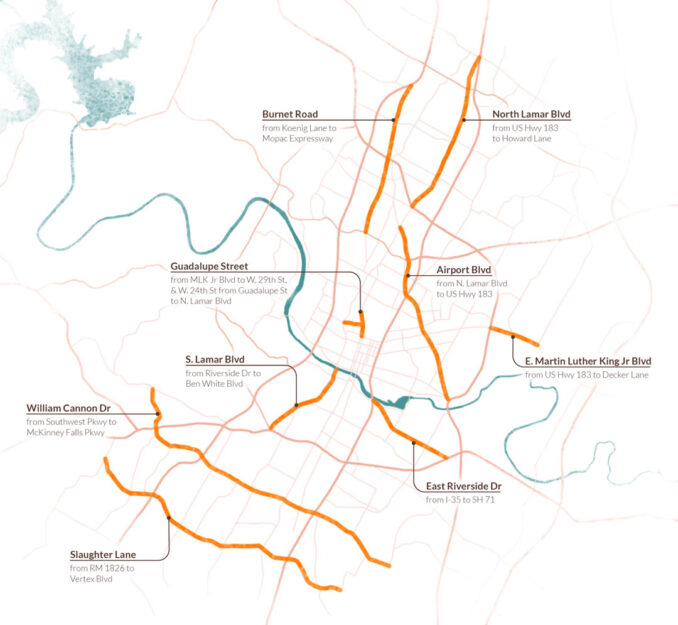
Our urban forest has the potential to provide a variety of economic and environmental benefits, however many urban trees fail to reach maturity and provide these benefits. The CPO Tree Manual and Toolkit, developed for the City of Austin’s Corridor Program Office, utilizes recent advances in urban arboriculture to establish improved standards for the city’s street trees. The manual‘s interactive tools, details, and specifications promote a holistic approach, proposing solutions to problems across all phases of development to ensure the long-term success of our urban forest.
The Corridor Program Office (CPO) was formed in response to Austin’s 2016 Mobility Bond, funding major improvements to nine mobility corridors throughout the city. Its mission was to support improvements to both mobility and livability, including alternate forms of transportation such as walking and biking. In the intense heat of Central Texas, shade trees play a critical role in the comfort and usability of these pathways.
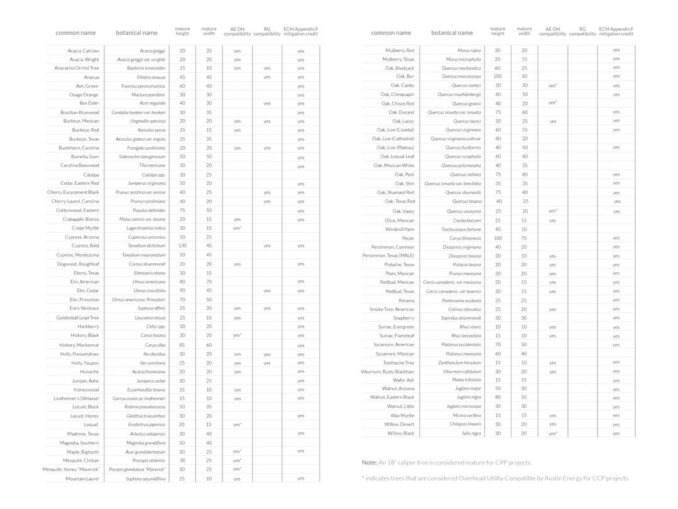
An assessment of existing trees throughout Austin’s urban core revealed that many are structurally weak and susceptible to disease and drought. Set in environments with a high proportion of impervious surfaces, and competing for space with various utilities underground, overhead, and at the surface, the mortality rate for newly planted trees is very high. The continued failure of trees at this city-wide scale is financially and environmentally costly, therefore this team was engaged to provide new standards and procedures to improve the survival rates, resiliency, and overall performance of street trees for CPO projects and beyond.
In researching the various causes of urban tree decline and death, it became clear that no single solution could address the wide range of issues. Improved design detailing wouldn’t address a problem developed during the tree’s early growth, and improved maintenance wouldn’t fix an installation error. A comprehensive approach—rethinking the entire process of growing, planting, and maintaining trees within the city—was necessary to improve urban tree health and survival. The team reviewed existing city details, specifications, and criteria manuals, conferred with specialists and industry experts including soil scientists, arborists, and product vendors, and conducted research into standards implemented across the country to rethink best practices for the City of Austin.

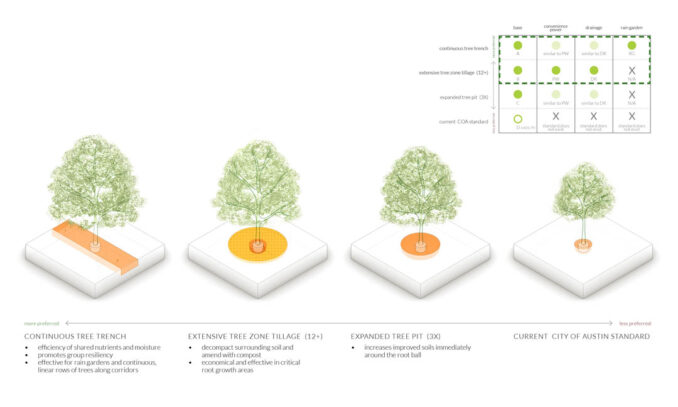
The manual’s interventions begin at the production phase, where problems arising during trees’ early growth stage at the nursery can later lead to significant defects and potentially premature failure. Poor production quality control, quantity shortages, and a lack of species diversity often lead designers and contractors to settle for what is available at the time of installation regardless of project goals. In addition to developing specifications prescribing better production practices, the team developed an inventory calendar tool to help plan future projects’ tree needs, allowing the CPO to contract with growers sooner to meet higher quality specifications and biodiversity objectives defined by the manual.
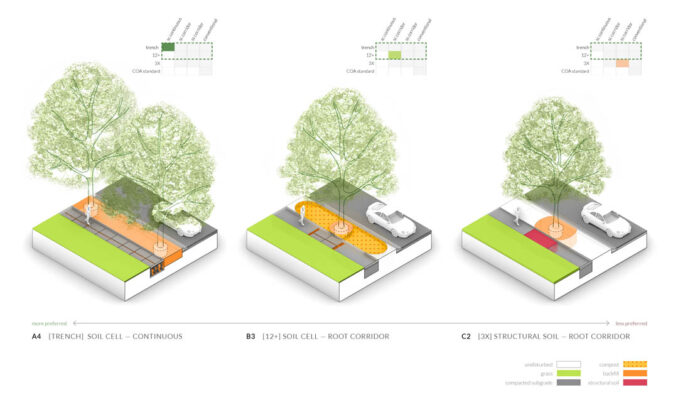
The widest range of challenges occur during the design phase. The critical goal was to clarify confusing, outdated, and often contradictory existing City standards, reducing misinterpretations while allowing for flexibility in response to site conditions. The team met with arborists, multiple city departments, and all major utility stakeholders to assess each group’s goals and requirements, then developed new details to resolve conflicts and promote best practices for tree health. The team produced recommended tree lists, increasing species diversity and helping designers select appropriate trees for various site conditions. New design details prioritize roots—expanding soil volume and reducing conflicts with underground utilities—as the critical path for achieving healthier, longer lived trees. The team developed multiple solutions that designers can mix, match, and adapt to accommodate a range of urban projects, as well as a cost comparison calculator to quickly assess an order of magnitude price for each solution.
During the installation phase, damage can occur from inadequate protection during transportation, neglect during staging, mishandling during installation, and improper placement of accessories such as stakes and root barriers. To reduce tree mortality due to installation defects, the team generated new specifications to help construction phase inspectors enforce higher quality results.
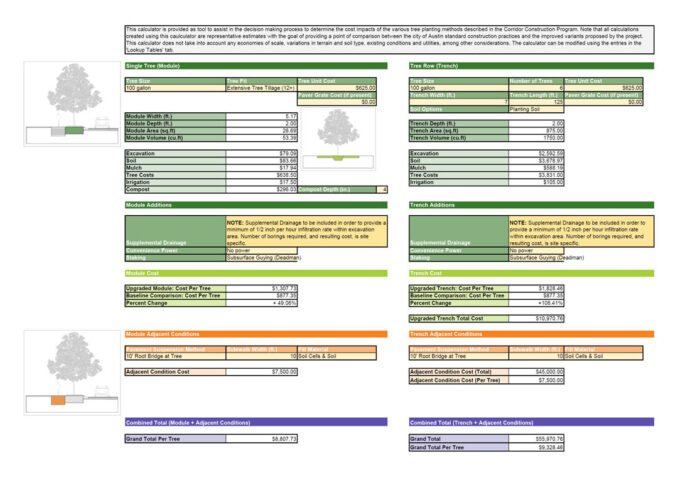
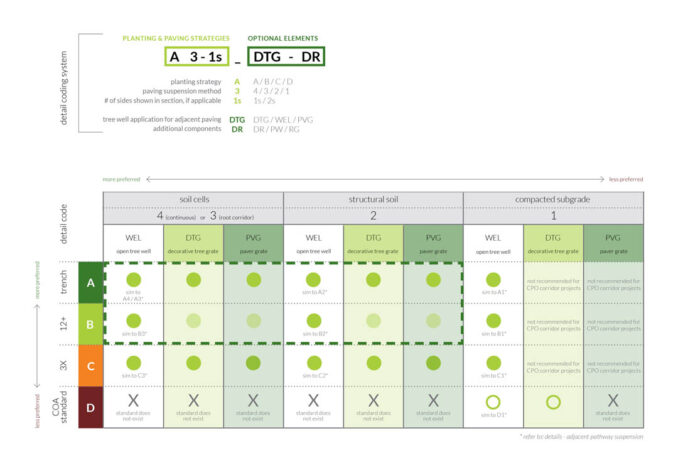
For the maintenance phase, the resources and specifications developed to support the ongoing health of trees include guidelines for irrigation monitoring, appropriate pruning, and maintaining structurally and biologically healthy soil. With the potential safety risks involved with falling limbs from unhealthy or dying trees, this phase is crucial to establishing a healthy urban forest and protecting the health and safety of Austin’s residents.
With rapid urban growth and a changing climate, tree health is more important than ever. The challenges of combining the conflicting needs of mobility, utilities, and trees in the congested rights-of-way require a holistic sequence of strategies. The integrated details, specifications, and procedures within the CPO Tree Manual and Toolkit will be the first of its kind in Austin to implement a new set of standards to optimize tree health and maximize their benefits into the future.
dwg. developed the CPO Tree Manual and Toolkit, developed for the City of Austin’s Corridor Program Office, utilizes advances in urban arboriculture to establish improved standards for the complete life cycle of the city’s street trees. The manual promotes a holistic approach, proposing solutions across all phases of development including tree production and procurement, design, installation, and maintenance to ensure the long-term success of our urban forest.
Images Credit: Courtesy of .dwg
